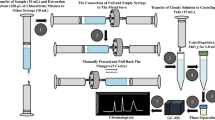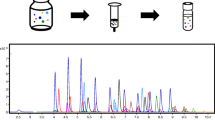Abstract
The rather long yet variable terminal half-lives and detection times since last use of urinary cannabinoids may partly be attributed to their enterohepatic circulation which generally can be interrupted or restricted by chemical adsorbents. Therefore, an in vitro experiment was performed to study the adsorption/binding of 11-nor-9-carboxy-Δ9-tetrahydrocannabinol (THC-COOH) and its glucuronide to activated charcoal and wheat bran; remaining concentrations were determined by liquid chromatography/tandem mass spectrometry. Adsorption/binding of 1,000 ng/mL of free or conjugated THC-COOH was complete using as little as 5 mg of charcoal whereas adsorption/binding to wheat bran increased with increasing amounts. Taking of remedies affecting enterohepatic recycling of THC-COOH and its glucuronide may challenge interpretation of cannabinoid concentrations used to detect or assess frequency of drug use or the time since last drug consumption.

ᅟ
Similar content being viewed by others
References
Huestis MA (2007) Human cannabinoid pharmacokinetics. Chem Biodivers 4:1770–1804
Watanabe K, Yamaori S, Funahashi T, Kimura T, Yamamoto I (2007) Cytochrome P 450 enzymes involved in the metabolism of tetrahydrocannabinols and cannabinol by human hepatic microsomes. Life Sci 80:1415–1419
Mazur A, Lichti CF, Prather PL, Zielinska AK, Bratton SM, Gallus-Zawada A, Finel M, Miller GP, Radominska-Pandya A, Moran JH (2009) Characterization of human hepatic and extrahepatic UDP-glucuronosyltransferase enzymes involved in the metabolism of classic cannabinoids. Drug Metab Dispos 37:1496–1504
Ramaekers JG, Kauert G, Theunissen EL, Toennes SW, Moeller MR (2009) Neurocognitive performance during acute THC intoxication in heavy and occasional cannabis users. J Psychopharmacol 23:266–277
Gustafson RA, Kim I, Stout PR, Klette KL, George MP, Moolchan ET, Levine B, Huestis MA (2004) Urinary pharmacokinetics of 11-nor-9-carboxy-delta9-tetrahydrocannabinol after controlled oral delta9-tetrahydrocannabinol administration. J Anal Toxicol 28:160–167
Schwope DM, Karschner EL, Gorelick DA, Huestis MA (2011) Identification of recent cannabis use: whole-blood and plasma free and glucuronidated cannabinoid pharmacokinetics following controlled smoked cannabis administration. Clin Chem 57:1406–1414
Musshoff F, Madea B (2006) Review of biologic matrices (urine, blood, hair) as indicators of recent or ongoing cannabis use. Ther Drug Monit 28:155–163
Gronewold A, Skopp G (2011) A preliminary investigation on the distribution of cannabinoids in man. Forensic Sci Int 210:7–11
Glaz-Sandberg A, Dietz L, Nguyen H, Oberwittler H, Aderjan R, Mikus G (2007) Pharmacokinetics of 11-nor-9-carboxy-delta(9)-tetrahydrocannabinol (THC-COOH) after intravenous administration of THC-COOH in healthy human subjects. Clin Pharmacol Ther 82:63–69
Böhnke E, Dietz L, Heinrich T, Aderjan R, Skopp G, Mikus G (2013) Disposition and enterohepatic circulation of intravenously administered 11-nor-9-carboxy-Δ9-tetrahydrocannabinol in serum and urine in healthy human subjects. J Forensic Toxicol Pharmacol. doi:10.417212325-9841.1000107
Roberts M, Magnusson BM, Burczynski FJ, Weiss M (2002) Enterohepatic circulation. Physiological, pharmacokinetic and clinical implications. Clin Pharmacokinet 41:751–790
Ciba Geigy Unlimited (1977) Geigy scientific tables, vol. 1: units of measurement, body fluid, composition of body, and nutrition. Ciba Geigy Unlimited, Basel, Switzerland
Skopp G, Pötsch L (2004) An investigation of the stability of free and glucuronidated 11-nor-delta9-tetrahydrocannabinol-9-carboxylic acid in authentic urine samples. J Anal Toxicol 28:35–40
Skopp G, Pötsch L, Mauden M, Richter B (2002) Partition coefficient, blood to plasma ratio, protein binding and short-term stability of 11-nor-delta(9)-carboxy tetrahydrocannabinol glucuronide. Forensic Sci Int 28:17–23
Gibaldi M (1991) Biopharmaceutics and clinical pharmacokinetics. Lea & Febiger, Philadelphia
Viau C, Zaoui C, Charbonneau S (2004) Dietary fiber reduce the urinary excretion of 1-hydroxypyrene following intravenous administration of pyrene. Toxicol Sci 78:15–19
Kupferschmidt H, Züst A, Rauber-Lüthy C (2009) Dekontamination und antidote bei akuten Vergiftungen. Ther Umscha 66:331–334
Olson KR (2010) Activated charcoal for acute poisoning: one toxicologist's journal. J Med Toxicol 6:190–198
Parisi GC, Zilli M, Carrara M, Bottona E, Verdianelli G, Battaglia G, Desideri S, Faedo A, Marzolino C, Tonon A, Ermani M, Leandro G (2002) High-fiber diet supplementation in patients with irritable bowel syndrome (IBS): a multicenter, randomized open trial comparison between wheat bran diet and partially hydrolyzed guar gum (PHGG). Dig Dis Sci 47:1697–1704
Brownlee IA (2011) The physiological roles of dietary fiber. Food Hydrocoll 25:238–250
Fernandez N, Dietz MJ, Teran MT, Garcia JJ, Calle AP, Sierra M (1998) Influence of two commercial fibers in the pharmacokinetics of ethinylestradiol in rabbits. J Pharmacol Exp Ther 286:870–874
Eastwood MA, Kay RM (1979) An hypothesis for the action of dietary fiber along the gastrointestinal tract. Am J Clin Nutr 32:364–367
Eastwood MA (1992) The physiological effect of dietary fiber: an update. Annu Rev Nutr 12:19–35
Acknowledgments
We thank Dr. L. Pötsch, Institute of Legal Medicine, Mainz, Germany, for useful discussion.
Author information
Authors and Affiliations
Corresponding author
Rights and permissions
About this article
Cite this article
Skopp, G., Mikus, G. An in vitro experiment on the interaction of charcoal or wheat bran with 11-nor-9-carboxy-Δ9-tetrahydrocannabinol and its glucuronide. Anal Bioanal Chem 405, 9449–9453 (2013). https://doi.org/10.1007/s00216-013-7381-4
Received:
Revised:
Accepted:
Published:
Issue Date:
DOI: https://doi.org/10.1007/s00216-013-7381-4




